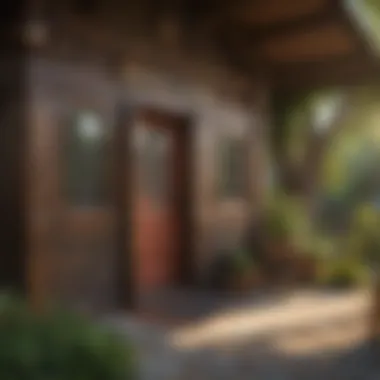Elevate Your Child's Play Space with a Vibrant Playhouse Painting


Playhouse Overview
Playhouses come in various types, ranging from quaint cottages to adventurous treehouses. Each type offers unique features and benefits that contribute to a child's play experience.
Features and Benefits
Playhouses boast durability, ensuring they withstand boisterous play sessions. Safety is paramount, with sturdy construction and rounded edges to prevent accidents. Additionally, playhouses stimulate a child's imagination by providing a designated space for creative play.
- Durability: Playhouses are built to endure rough play.
- Safety: Rounded edges and secure structures enhance child safety.
- Imagination stimulation: Dedicated play spaces encourage imaginative play.
Buying Guide
When selecting a playhouse for your child, consider crucial factors such as material, size, theme, and interactive elements. Material quality affects durability, while size should complement your available space. Themes can range from fairy-tale castles to pirate ships, catering to different interests. Interactive elements like slides and climbing walls add thrill and engagement to the play experience.
- Material: Choose sturdy materials for long-lasting playhouses.
- Size: Match the size of the playhouse to your available space.
- Theme: Explore various themes to suit your child's preferences.
- Interactive elements: Incorporate engaging features for added fun.
Maintenance Tips
To ensure the longevity of your child's playhouse, follow maintenance tips such as regular cleaning and proper storage. Cleaning instructions may include using mild detergents for gentle cleaning and inspecting for any damage. Storing the playhouse during extreme weather conditions can prevent wear and tear, preserving its quality.
- Cleaning instructions: Use mild detergents for gentle cleaning to maintain playhouse hygiene.
- Storage recommendations: Store the playhouse indoors during harsh weather to protect it from damage.
Customization Options
Elevate your child's play experience with creative customization options. Choose from paint-your-own playhouse kits for artistic expression, DIY playhouse kits for family bonding, or build your own playhouse for tailored designs. Additionally, unique accessories such as curtains, decorations, and furniture can enhance the play space, reflecting your child's personality and interests.
- Paint Your Own Playhouse Kits: Encourage creativity through personalized designs.
- DIY Playhouse Kits: Bond as a family while constructing a unique play space.
- Build Your Own Playhouse: Customize designs to reflect your child's interests.
- Unique Playhouse Accessories: Enhance the play space with personalized touches.
Introduction
Understanding the Importance of Playhouses
The Role of Play in Child Development
One of the key elements in a child's developmental journey is play, which plays a crucial role in shaping their cognitive, social, and emotional skills. Through play, children learn to explore their surroundings, solve problems, and interact with others. Play helps in fostering creativity, imagination, and adaptability in children, making it an essential tool for their overall growth.
Benefits of Playhouses
Playhouses serve as more than just a physical structure; they provide a dedicated space for children to engage in imaginative play, encouraging them to create their own worlds and narratives. These play spaces offer privacy, ownership, and a sense of independence to children, allowing them to develop autonomy and decision-making skills from a young age.
Overview of Painting a Playhouse
Benefits of Painting
Painting a playhouse not only enhances its visual appeal but also serves as a means of self-expression for children. It stimulates their creativity and allows them to personalize their play space according to their preferences, fostering a sense of ownership and pride. Additionally, painting can transform a plain structure into a vibrant and inviting area that sparks joy and imaginative play.
Factors to Consider


When painting a playhouse, several factors need to be taken into account, such as the type of paint used, color selection, and durability. Choosing non-toxic options like water-based or low-VOC paints is crucial to ensure the safety of children who will be interacting with the playhouse. Considering factors like weather resistance, durability, and ease of maintenance can help prolong the lifespan of the paint and the playhouse itself, providing a long-lasting and enjoyable play experience for children.
Choosing the Right Paint
When it comes to enhancing your child's play experience by painting a playhouse, selecting the right paint is a crucial aspect that requires careful consideration. The choice of paint can impact not only the aesthetic appeal of the playhouse but also the safety of the environment in which your child will be playing. By focusing on specific elements such as non-toxic options, durability, and color selection, parents and caregivers can create a vibrant and safe play space that fosters creativity and imagination.
Non-Toxic Options
Water-Based Paints
Water-based paints are a fundamental choice when painting a playhouse due to their eco-friendly nature and low levels of toxicity. These paints are known for their quick drying time, easy cleanup with water, and minimal odor, making them a popular choice for indoor playhouses where ventilation may be limited. The key characteristic of water-based paints lies in their non-harmful fumes, ensuring a safe environment for children to play. While they offer excellent coverage and color options, some drawbacks include a potentially shorter lifespan compared to oil-based paints.
Low-VOC Paints
Low-VOC (Volatile Organic Compound) paints are another suitable option for playhouse painting, especially for parents concerned about indoor air quality and their child's health. These paints emit fewer harmful chemicals into the air, reducing the risk of respiratory issues and allergies. The key characteristic of low-VOC paints is their minimal impact on indoor air quality, making them a beneficial choice for parents looking to create a healthy play environment. However, despite their eco-friendly composition, some low-VOC paints may have limited color options and require additional coats for optimal coverage.
Color Selection
When selecting colors for the playhouse, it is essential to consider both the psychological impact of colors and your child's preferences. The hues you choose can influence your child's mood, level of creativity, and overall engagement in play activities.
Psychological Impact of Colors
Different colors evoke various emotional responses and behaviors in children. For example, vibrant colors such as red and yellow can foster energy and excitement, while calming colors like blue and green may promote relaxation and concentration. Understanding the psychological impact of colors allows parents to create a play environment that stimulates cognitive development and emotional well-being. However, it is crucial to strike a balance between stimulating colors and soothing tones to cater to different play moods.
Child's Preferences
Considering your child's preferences when selecting paint colors for the playhouse can enhance their sense of ownership and enjoyment. Involving your child in the color selection process not only encourages their creativity but also allows them to express their personality through their play space. By incorporating your child's favorite colors or themes into the playhouse design, you can create a personalized and inviting atmosphere that inspires imaginative play.
Preparation
Preparation plays a pivotal role in the process of painting a playhouse, setting the foundation for a successful and visually appealing outcome. In this article, we delve deep into the significance of thorough preparation, emphasizing its crucial aspects and the benefits it offers to create a durable and beautiful finish. Parents and caregivers looking to enhance their child's play experience through painting a playhouse will find this section especially enlightening.
Cleaning and Sanding
Removing Dirt and Debris
Removing dirt and debris from the playhouse surface is a fundamental step in the preparation process. By eliminating any impurities, such as dust, grime, or old paint residues, you ensure a clean canvas for the new paint to adhere to effectively. This meticulous cleaning not only enhances the paint's adherence but also prevents potential issues like peeling and uneven application. Implementing proper techniques for removing dirt and debris is vital to guarantee a smooth and durable paint finish.
Smooth Surfaces for Painting
Achieving a smooth surface before painting is essential for a professional-looking result. Smoothing out rough areas, imperfections, and previous paint layers facilitates better paint adhesion and ensures a seamless finish. By addressing uneven surfaces through sanding and levelling techniques, you create an optimal condition for the paint to bond evenly and reduce the risk of flaws in the final appearance. Prioritizing smooth surfaces not only enhances the aesthetic appeal of the playhouse but also prolongs the longevity of the paint job.
Priming the Surface
Importance of Primer
Priming the playhouse surface before painting is a critical preparatory step that significantly impacts the overall outcome. The primer serves as a base coat that enhances paint adhesion, promotes durability, and improves color vibrancy. By sealing porous surfaces, blocking stains, and providing a uniform base, primer ensures a consistent finish and prevents paint from flaking or peeling over time. Acknowledging the importance of primer in the painting process can elevate the quality and longevity of the playhouse transformation.


Types of Primers
Choosing the right type of primer for the playhouse surface is key to a successful paint job. Different primers offer unique features and benefits, such as stain-blocking, adhesion promotion, and mold resistance. Understanding the specific characteristics of various primers, including water-based, oil-based, and shellac primers, enables you to select the most suitable option based on the surface material and desired outcome. Exploring the pros and cons of different primer types equips you with the knowledge to make informed decisions and optimize the performance of the paint on your child's playhouse.
Painting Techniques
Painting techniques play a crucial role in elevating the aesthetic appeal and durability of a playhouse, making it a visually captivating and long-lasting space for children's play and imagination. Understanding the nuances of different painting methods is essential in achieving a high-quality finish that not only enhances the look of the playhouse but also protects it from weather elements and wear.
Utilizing the appropriate painting techniques ensures that the paint adheres well to the surface, providing a smooth and even coat that enhances the visual impact of the playhouse. Moreover, employing the right techniques can improve the longevity of the paint job, reducing the need for frequent touch-ups and maintenance.
Considerations such as brush strokes versus spray application, layering techniques, and decorative patterns all contribute to the overall outcome of the painted playhouse. By mastering these techniques, parents and caregivers can create a personalized and visually stimulating play environment for children to enjoy.
Brush vs. Spray
Pros and Cons
When it comes to choosing between brush painting and spray application for a playhouse, there are distinct advantages and disadvantages to consider. Brush painting allows for greater precision and control, making it ideal for detailed areas and intricate designs. On the other hand, spray painting offers a faster and more even application, covering large areas quickly and efficiently.
The key benefit of brush painting lies in the ability to achieve finer details and nuances in the paint job, enabling creativity and customization. However, brush painting may take longer to complete, especially on larger surfaces, and requires a steady hand to ensure a smooth finish.
In contrast, spray painting offers speed and uniform coverage, making it a popular choice for large playhouses or those with extensive surface areas. While spray painting can be more efficient, overspray and drift may occur, necessitating careful masking and protection of surrounding areas.
Best Practices
To optimize the painting process for a playhouse, it is essential to follow best practices tailored to the chosen method. For brush painting, selecting high-quality brushes and using long, smooth strokes can help achieve a professional finish. It is recommended to work in small sections, ensuring consistent coverage and avoiding visible brush marks.
On the other hand, when using spray painting techniques, proper ventilation and protective gear are crucial to ensure safety and prevent inhalation of fumes. Maintaining the right distance from the playhouse surface and employing even, overlapping strokes can result in a seamless finish without drips or uneven patches.
By adhering to best practices for both brush and spray painting, parents and DIY enthusiasts can enhance the visual appeal of the playhouse while optimizing the efficiency and quality of the painting process.
Safety Considerations
Ensuring safety measures are implemented is paramount when engaging in any painting project, especially one involving a child's playhouse. In this article, Safety Considerations play a crucial role in safeguarding not only the structural integrity of the playhouse but also the well-being of the children interacting with it. By emphasizing caution and adherence to safety protocols, parents and caregivers can create a secure play environment for their little ones.
Ventilation and Protection
Outdoor Painting Tips
When delving into outdoor painting, it is essential to consider factors such as adequate ventilation and protective measures. Outdoor Painting Tips focus on optimizing the painting conditions to ensure proper air circulation, which aids in the drying process and minimizes the inhalation of fumes. Moreover, protecting surrounding surfaces from overspray and splatters is vital to maintain a clean work area and prevent unintended paint application.
Protective Gear
The use of Protective Gear is indispensable when engaging in painting activities, particularly outdoors where exposure to elements is heightened. Protective Gear includes items like gloves, goggles, and respiratory masks, offering physical protection from paint splatters, fumes, and airborne particles. By donning the appropriate gear, individuals can safeguard their health and prevent potential injuries, ensuring a safe and controlled painting experience.
Child-Friendly Finishes
Low-Odor Options


Opting for Low-Odor Options in paints contributes significantly to creating a child-friendly environment during and after the painting process. Low-odor paints emit minimal volatile organic compounds (VOCs), reducing strong paint odors that could be overwhelming, especially for young children. This choice prioritizes air quality and minimizes exposure to potentially harmful chemicals, promoting a healthier play space for children.
Washable Paints
The versatility of Washable Paints makes them an ideal choice for playhouses, where messes and stains are inevitable. Washable Paints allow for easy cleanup with water and mild soap, ensuring that artistic endeavors or accidental spills can be swiftly rectified. Offering both durability and convenience, washable options prove to be a practical and parent-friendly choice for maintaining the aesthetic appeal and cleanliness of the playhouse.
Maintenance and Care
In the realm of enhancing your child's play experience through painting a playhouse, maintenance and care play a pivotal role in ensuring the longevity and vibrancy of the structure. This section delves into the essential practices and considerations regarding the upkeep of the painted playhouse, highlighting key elements that parents and caregivers should prioritize.
Maintenance and care are crucial aspects to uphold the integrity of the playhouse and preserve the aesthetic appeal over time. Regular maintenance routines not only maintain the visual attractiveness of the playhouse but also contribute to its durability, ensuring that it withstands varying weather conditions and continues to be a safe and enjoyable space for children.
Considering the significant investment of time and effort put into painting a playhouse, proper maintenance is essential to ensure that the colors remain vibrant and the structure remains structurally sound. Touch-ups, sealant reapplication, and gentle cleaning methods are integral components of the maintenance regimen that parents should incorporate into their routine to prolong the life of the playhouse.
Longevity of Paint
Touch-Ups
Touch-ups represent a crucial aspect in preserving the pristine appearance of the painted playhouse. They involve repairing any chipped or faded areas by applying small amounts of matching paint to restore the continuity of the color scheme. Touch-ups are particularly beneficial for addressing minor damages and maintaining the overall visual cohesiveness of the playhouse.
The key characteristic of touch-ups lies in their ability to address localized imperfections without the need for extensive repainting, saving time and effort while effectively rejuvenating the appearance of the playhouse. This practice is popular among parents and caregivers as it allows for targeted maintenance and prevents the need for complete repainting, extending the lifespan of the original paint job.
Touch-ups offer a unique feature by providing a quick and cost-effective solution for maintaining the playhouse's aesthetics. While advantageous in preserving the look of the playhouse, it is essential to note that touch-ups may require careful color matching and blending to ensure a seamless finish that complements the existing paintwork.
Sealant Reapplication
Sealant reapplication is a critical step in enhancing the longevity of the paint job on the playhouse. Sealants act as protective barriers against moisture, UV rays, and other external factors that can cause the paint to deteriorate over time. By reapplying a fresh coat of sealant periodically, parents can safeguard the painted surfaces from wear and tear, thereby extending the lifespan of the paint.
The key characteristic of sealant reapplication lies in its ability to reinforce the paint's durability and resistance to environmental elements, providing an additional layer of protection that maintains the playhouse's pristine appearance. This practice is a popular choice among parents seeking to preserve the vibrant colors and integrity of the playhouse's exterior.
Sealant reapplication offers a unique feature by ensuring long-term color retention and structural integrity, enhancing the overall aesthetics and functionality of the playhouse. While advantageous in prolonging the lifespan of the paint job, it is important to follow manufacturer guidelines and use high-quality sealants to achieve optimal results.
Conclusion
Personalizing Your Playhouse
Creative Expression
Creative expression plays a pivotal role in personalizing a playhouse, allowing children to showcase their individuality and creativity in a tangible way. By incorporating unique design elements, imaginative patterns, and custom artwork, children can transform their play space into a reflection of their personality and interests. Creative expression fosters a sense of ownership and pride, empowering children to make their playhouse truly their own. While creativity brings joy and excitement to the painting process, it also promotes cognitive development and critical thinking skills, making it a valuable aspect of enhancing your child's play experience through painting a playhouse.
Memorable Play Experiences
Creating memorable play experiences is essential in enriching your child's play environment and fostering meaningful interactions. By incorporating elements that evoke positive emotions and nostalgia, such as personalized murals, themed decoration, or collaborative projects, parents can create a space where lasting memories are made. Memorable play experiences encourage creativity, social engagement, and sensory exploration, enhancing the overall quality of playtime and strengthening parent-child bonds. By prioritizing memorable play experiences in the design and painting of a playhouse, caregivers can ensure that children cherish their play space for years to come.
Final Thoughts
Enjoying the Process
Enjoying the process of painting a playhouse is an integral part of creating a positive and engaging play experience for children. By involving children in the painting process, parents can cultivate their creativity, problem-solving skills, and sense of accomplishment. The act of painting together fosters bonding and communication, making it a shared experience that brings joy and fulfillment to both children and caregivers. Enjoying the process of painting a playhouse not only enhances the final result but also creates fond memories that children will treasure.
Creating Lasting Memories
Creating lasting memories through the painting of a playhouse enriches the play experience and adds a sentimental value to the space. By incorporating elements that hold personal significance, such as handprints, messages, or special designs, parents can create a playhouse that tells a story and captures precious moments in time. Lasting memories strengthen the emotional connection children have with their play space, fostering a sense of nostalgia and belonging. By creating lasting memories through painting a playhouse, parents can ensure that the play environment holds enduring value and significance for their child.



